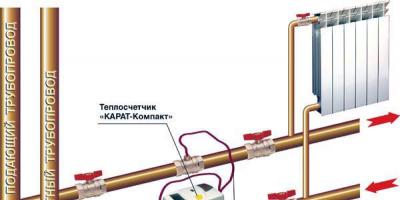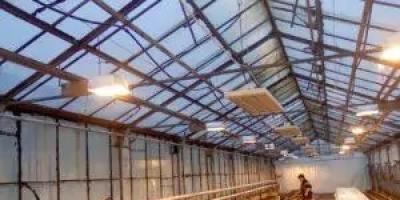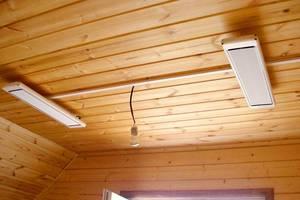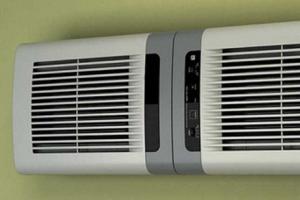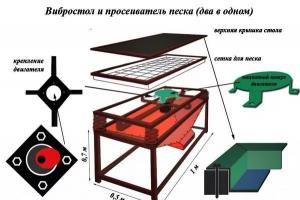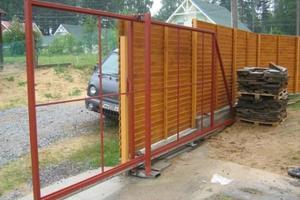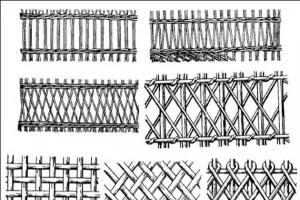The durability of the structure depends on the quality of drying of the wood, otherwise the timber may bend over time, rot, and insects and fungus will certainly grow in it. So how to dry timber without cracks and residual harmful moisture? After all, only proper drying will improve the mechanical qualities of wood, prevent its warping, rotting and cracking.
Note that the instructions state: the moisture content indicates the amount of water in the wood. By the way, this moisture can be both free and bound. But free moisture evaporates well, lightening the wood, while bound moisture leaves very slowly.
Features of dried timber

It is clear that first moisture from the outer layers evaporates intensively. This is what creates a lot of stress in the wood: stretching of the surface and the appearance of cracks.
Types of timber
Experts clarify how to dry timber with different shrinkage coefficients:
- low-drying - pine, spruce, fir, white poplar, cedar;
- medium drying- beech, oak, aspen, elm, black poplar, ash, small-leaved linden;
- highly drying– hornbeam, Norway maple, birch, larch.
Percentage = weight of water in wood/weight of dry wood.
Properties of dried lumber
Let's summarize the goals of drying timber:
- increase the safety of the material;
- enhance strength properties;
- avoid the appearance of cracks;
- strengthen connections;
- simplify construction work;
- increase insulating abilities;
- protect the wood by painting immediately after installation;
- reduce inevitable changes to the finished building;
- improve the surface without additional cladding.
Methods for creating dried timber
Atmospheric, natural

- The beams are stored in stacks under awnings on outdoors a few months.
- We will cover their ends with glue or lime to avoid cracks.
- But due to changes in weather, humidity and temperature, the material sometimes becomes deformed and small cracks form.
Chamber

A highly effective alternative to the atmospheric method is chamber drying.
- Timber in drying chambers equipped with heating coils, fans, and air ducts facilitate uniform, proper drying.
- The effectiveness of such drying is undeniable: we do not depend on the weather, and the process is controlled by a computer, reducing time but increasing volumes.
Note! Freshly sawn it already has 20% moisture content.
Generator
Drying with high frequency generators.
- Here the wood in the circuit of this generator is the dielectric in the capacitor ( Electric Energy served alternating current turns into heat).
- The timber, when heated, dries intensively and evenly.
- But the energy costs are significant, which means the price of the timber is higher. By the way, ready-made dry timber is always 2 times more expensive.
Types of drying chambers
Convective

IN convection chambers Energy comes to the wood from the air cycle, and heat transfer occurs through convection.
There are 2 types of such cameras.
- Channel dryers continuous action, where the stacks are continually pushed further into a drier place in 4 to 12 hours. We load the tunnel from the “wet” edge, and unload it from the opposite, “dry” edge.
- Special batch drying kilns are smaller than tunnel kilns and may only have 1 door. But environmental parameters, airflow, ventilation reversal guarantee ideal drying. After drying is completed, the chamber is completely emptied and loaded with raw logs, which increases energy losses by 20% than in tunnel chambers.
Condensation

- The condensation chamber collects evaporated moisture on the coolers and discharges it into the sewer system.
- But here heat pumps do not give high temperatures, so the cycle is slowed down.
- Electricity is provided by the cooler compressor.
Innovative

- Vacuum chambers with a pressure of 0.5 bar speed up the drying of the timber with a complete absence of warping and cracking.
- Microwave chambers, electromagnetic dryers are also innovations, as are hot air dryers.
Drying at home
High-quality drying of timber at home can be carried out using one of the following methods.
Natural drying

Advice! It is worth finding out the time of cutting a tree for timber: in autumn and winter there is no movement of sap, which means that humidity is minimal - the logs will dry out quickly.
Conditions for proper drying:
- Selection of material of the same thickness and type.
- Straight stacked material: Straight stacks and trellises between rows will increase air circulation.
- Pads at the base.
- Pegs under each other and intermediate boards in a row with pegs;
- Optimal air movement: not dense placement, so that the air flows horizontally.
- Air dampers for uniform ventilation of stacks.
- The canopy will protect from rain and sun, and a ventilated area of the site will speed up the process.
Note! Long-term drying of timber drying timber at home guarantees humidity less than 18%.
Thermal chamber
- Imitation of a dryer: non-residential premises with brick stove and heating along the walls.
- We build stacks with our own hands, lay trellises along the rows and heat the stove, raising the temperature to 50 degrees.
- Then the room cools down to + 20.
- Let's repeat the cycle.
- In a week the timber is ready.
Advice! Final only in a heated room. Therefore, ventilated attics, heated sheds and garages, and residential buildings are the best storage and drying areas.
Conclusion
- We carry out primary drying in warm air, minimal humidity, but under natural conditions.
- We build the platform on pillars.
- We place the timber across and lengthwise on thin slats (for free ventilation).
It is not easy to find out the moisture level of the resulting dried wood at home. The master determines it by mass, by eye or by sound (dry wood rings when tapped).
Experienced practitioners recognize the degree of moisture from the shavings: they tie long shavings in a knot. If the shavings do not collapse, then the wood is still damp, and if it disintegrates, it is already dry. But let’s pay attention to the core of the timber - it is sometimes more wet, then it’s worth drying a little more.
The video in this article has the additional information we need on this topic.
During operation wooden houses or baths, cracks begin to appear in the timber. This process cannot be prevented, as it is typical for wooden buildings.
Why is it advisable to seal cracks in timber?
Small cracks on the surface of the wood do not affect negative influence for the operation of the building. Most often they can be of the nature decorative element, giving the logs some individuality. But still, the appearance of cracks should not be treated negligently.
If cracks in timber are more than 5 mm wide and spread throughout the entire log or beam, then measures must be taken to prevent their spread. Why do this?
- Water will get inside the cracks, the moisture content of the wood will increase and it will begin to rot.
- Wood cracks are a favorite place for various bark beetles, which, feeding on wood, will render even the most durable logs unusable.
Therefore, if deep cracks are detected, they must be repaired immediately.
Prevention of cracks
To prevent cracks from appearing in timber, a number of measures must be taken.
Sealing cracks in timber:
Preventive measures help prevent the occurrence of large quantity cracks, but they are not able to completely eliminate their formation. Can be hidden cracks in timber, prevent rotting processes in them by sealing.
Sealing cracks in timber possible different ways. The materials most often used for this are air-hardening putties, dry mixtures, and sealants.
Methods for sealing cracks in timber
The methods described above for sealing cracks can be used both outside and inside a timber house. All methods do not harm the wood, help remove cold bridges and increase the strength of the tree.
Wood has been and remains the most popular material when building a house. This beautiful, environmentally friendly, safe, fragrant, warm material Perfectly suits all different types of buildings. However, it also has disadvantages. No matter how diligently the owners take care of the house, cracks will still appear. So, how to avoid cracking of timber in a wooden house?
Which cracks are dangerous?
The danger lies not in the cracks themselves, which will appear sooner or later anyway, but in their depth. After all, if they reach the core of the timber used in construction, this will not only significantly damage appearance home, but will also significantly reduce the strength of the building. That's why experts recommend taking a closer look at the condition of your home, keeping an eye out for cracking, and doing everything possible to prevent the cracks from getting deeper.
The initial cause of cracks
Before you figure out how to avoid cracking of timber in a wooden house, it is worth finding out why timber cracks. This happens for one very simple reason. The timber is dried unevenly, because drying the middle always takes more time than the upper layers, so during natural drying the log seems to dry out, but in fact the core remains damp. To prevent this from happening, it is better to purchase logs that have been dried in special drying chambers.
What kind of wood is best to take for construction?
In order not to find out how to avoid cracking of timber in a wooden house, immediately after construction, It is better to buy northern wood for construction, which has been tarred before sale. It is resistant to the appearance of cracks, and if they appear, then only on the surface, without penetrating deeper. But if the wood has already been used and the house has been built, what should I do? Understand the causes of cracking and take action.
Reasons for cracking of timber in a finished house
To maintain the normal condition of the wood, measures must be taken to maintain a balance between the dry and wet layers of the timber. What can disrupt it?
- Spring sun. To prevent the wood from cracking in the spring, experts advise taking measures and protecting the house with special protective materials that will prevent moisture from evaporating from the wood.
- Warmth from stove heating. Not only the sun, but also the usual stove can dry out wood. But if the sun does it from the outside, then the furnace does it from the inside. For the first two years after construction, you should not heat the stove so that the timber does not crack.
How to protect wood?
So, how to avoid cracking of timber in a wooden house? It is enough to follow some rules, and there will be significantly fewer cracks, and the ones that appear will not cause trouble.
- When choosing materials, you need to pay attention to the profile of the timber being sold and the compensation groove. If the latter is done correctly and with utmost precision, it is unlikely that it will ever become covered with cracks.
- From March to May, the house should be covered with ultraviolet protection products.
- During the construction and settling of a house, the ends of the timber are treated with substances containing lime. The fact is that they do not allow moisture to evaporate and, therefore, the timber to dry out.
- To care for wooden building we need better stuff. Most suitable option– those that contain not only filters from ultraviolet radiation, but also linseed oil.
What if cracks appear?
Cracks that appear must be repaired quickly so that moisture does not evaporate through them, otherwise the timber will crack even more. Sealant, ordinary putty and caulking are suitable for closing. Paint is applied on top. If cracks appear inside the rooms, they are covered with sawdust and plastered. But when large cracks appear, you will have to use sealant.
June 27, 2018
Causes of cracks in timber and ways to prevent their formation
1.Cracks in timber are formed due to uneven shrinkage
Cracks in timber occur because the humidity inside the timber is higher than outside. Thus, the outer part of the bar “breaks”, because she is bursting from the inside.
In the language of specialists and in the textbook, such defects in wood building materials are classified as follows: “Cracks are longitudinal breaks in wood, formed under the action of internal stresses reaching the tensile strength of wood across the grain...”. There are different types of cracks in lumber, but in this article we discuss cracks shrinkage, the reasons for their occurrence and ways to overcome their occurrence in timber.
The moisture content of the timber and its drying affect the quality of the wood of the building material. Drying can be atmospheric or chamber: in the first case, the timber dries out naturally, and in the second case, it is forced. The formation of cracks in the timber depends on how chamber drying is carried out and whether its technologies are followed.
Drying wood is accompanied by an uneven distribution of moisture in the body of the bar, which causes an uneven level of humidity in the wooden building material and leads to the formation of internal stress in it.
During atmospheric drying, the timber naturally reaches the required humidity, while shrinking in the log house for up to six months. Thus, the drying process is delayed in time, but the internal stress in the wood is often balanced (or approaches its values) with the external one, because In the natural environment, air humidity is higher than in drying chamber, which smoothes out the effects of wood expansion from the inside. Simply put, when drying from the inside, the timber is saturated with atmospheric moisture from the outside, which leads to a slowdown in the drying process, but, at the same time, to a more gentle drying, a gradual balancing of humidity outside and inside in accordance with the environment.
In order to speed up construction, developers sometimes resort to purchasing a log house made from kiln-dried timber in order to get a house immediately without shrinkage, on a turnkey basis. Such construction is not only much more expensive, because... dry lumber is higher in price due to the electricity consumption for its production, but also leads to a poor-quality structure - some manufacturers of dry lumber violate the drying technology when drying it at high speed.
It is not enough to simply place the raw material in the drying chamber and turn on high temperature. Special temperature conditions must be observed throughout the entire production of dry lumber, and at the end also include steam to prevent cracking of the wood from the outside, to soften it so that internal stress does not tear the outer layers.
2. An expansion groove in the timber helps prevent cracks from forming

One of the ways to overcome internal stress in timber and, therefore, minimize the formation of shrinkage cracks in timber is the so-called. “compensation grooves” in the timber, which are sawed simultaneously with the manufacture of the wooden building material itself.
The unloading cut relieves some of the internal stress in the block, because functions as if artificial cracks - they are made in advance, before real ones appear, but since they are hidden during the assembly of the log house under the lower and upper crowns, they become invisible and do not spoil general form buildings.
When a timber that has dried out from the outside bursts with tension from the still wet middle part from the inside, it either tears on the sides, forming cracks, or opens slightly in the compensation grooves. When the moisture leaves from the inside, it closes again and the block takes on its original, albeit already shriveled, shape.
Visually, changes in the unloading cut are difficult to notice and this does not affect mechanical properties wood and log quality.
A compensation groove is also made in the timber natural humidity, and dry. It helps overcome internal tension in wood, regardless of how moisture leaves it - naturally during shrinkage or forced in a drying chamber.
The presence of a relief cut in the timber does not guarantee the complete absence of cracks, but significantly reduces their formation: the softer and more natural process the release of moisture from the wood structure, the less formation of deformations in it.
3. Other reasons for the formation of cracks in timber
Another reason for the formation of cracks in timber is sawing the timber through the core of the log. In the case of using sawing without a core, the timber does not shrink during shrinkage, and the formation of cracks is minimized.
You can determine which part of the log the timber was made from by looking at the annual rings on the ends of the lumber: they are wider at the core and narrow towards the edges. But this is often only possible for specialists and the average person does not pay attention to these details. Therefore, when choosing a building material, consider the timber not only from the sides, but also from the ends.

So, to build a beautiful and quality house made of timber, pay attention to the quality of the lumber from which your country building will be built. It is important how the house will be built: from timber with natural moisture for shrinkage or from dry timber, which is used for construction immediately before finishing. Atmospheric drying of timber involves the formation minimum quantity cracks, in contrast to forced drying timber, the manufacturing technology of which may be disrupted, especially during the hot construction season.
Ask your lumber suppliers about the presence of an expansion groove in the timber. Although the unloading cut does not completely prevent the formation of cracks, it significantly reduces their number.
When inspecting the supplied wooden building material, pay attention not only to the side parts, but also to the ends of the beam, which can tell a lot about the quality of the log used in the manufacture of the beam.
Both stone and wood, the process is quite complex. In order for you to live happily ever after in your home, you need to take care of your home. Sometimes something needs to be repaired, something needs to be completed. If during drying all the moisture has not evaporated from the wood, and you have purchased poorly dried timber, then with a high degree of probability you can expect cracks on the drying wooden facade. Such cracks are the reason why cold will penetrate into the building. In the worst case, the wall may still blow through. Let's look at where cracks can appear and what measures you can take to eliminate them yourself.
Typically, the drying rate of wood is 1 cm in 5 months. For a house measuring 150x1500mm, it will take 5-6 years for the wood to completely dry out and stop cracking and shrinking. As experts say, when you see cracks on the facade wooden house There's no need to panic. They can even be left as a highlight in the interior. But only until the width of the cracks becomes more than 2 cm. Wood with cracks of such a width will not remain intact for a long time. If we talk about the depth of cracks, then the maximum depth that is permissible is 5 cm. Deeper cracks will cause damage to your home.
Reasons why timber cracks
The very first and most common reason for the appearance of cracks is poor quality of the material. It all depends on how well timber was dried. It should be borne in mind that the outer layer of wood dries much faster than the inner one. Therefore, the outer layer cracks and decreases in size, which leads to cracks. Usually, after finishing the construction of a wooden house, it is worth monitoring the appearance of cracks. In two or three weeks they may appear on the front of the house. After a month has passed, timber should completely dry out, and the cracks will reach 2-3 cm. There is a chance to prevent the appearance of cracks for this reason by drying timber on one's own. To do this, you need to place it in the shade. timber in rows, observing two details. The first detail is that the wood must be raised at a distance of 30 cm from the ground and laid in rows, and the second detail is that there must be “gaskets” of boards between the rows so that air can pass freely between them.
The second reason why cracks may appear is if the load on the frame was calculated incorrectly. In this case, it doesn’t even matter whether the wood is well dried or not. To eliminate this reason for the appearance of cracks, you need to be careful at the design stage. All strut loads in the project must be checked. If necessary, add more to relieve the overall weight of the roof.
The third reason is incorrect installation, when cracks appear at the joints of the logs. For this reason, the appearance of “cold bridges” should not be surprising. To eliminate this cause of cracks, even at the construction stage it is necessary to fit all the parts of the log house tightly to each other. In places where windows and doors will be installed, it is necessary to make special expansion gaps. This will reduce the load on the walls, and therefore reduce the risk of gaps between the logs.
The fourth reason for cracks in wood is related to heating. Less than competent specialists can start heating wooden house in the first season. This leads to cracks appearing both outside and inside. Temperature changes are not good for wood. Due to such differences, the humidity in the logs changes, which contributes to the appearance of cracks. It should be remembered that timber should not “know” what heating is for one year, or better yet two years. 
The most famous ways to get rid of timber from cracks - this is with the help of joint sealant, PVA and sawdust. You can purchase joint sealant at any store that specializes in building materials and related items. The advantage of this method is that you can easily match the sealant to the color of the wood. The downside is that the sealant shrinks during use, so you will have to apply the sealant again after a couple of days. Typically, this method is suitable for eliminating cracks up to 1 cm wide. For cracks that are much wider, a proven method is used by many specialists. We prepare small sawdust, and then buy PVA glue. Both ingredients are mixed together until smooth. We seal the cracks with the same mixture and leave for 2-3 hours. The result justifies all expectations. You can also choose wood that will be least susceptible to cracks. The most resistant wood is considered to be from the northern regions. But the wood of southern tree species is not so resistant. Cracks can appear in it very quickly and reach the middle of the log. Another way to prevent cracks in wood is to treat the ends. For it to work, the processing of the ends must be carried out during the natural drying of the wood.

